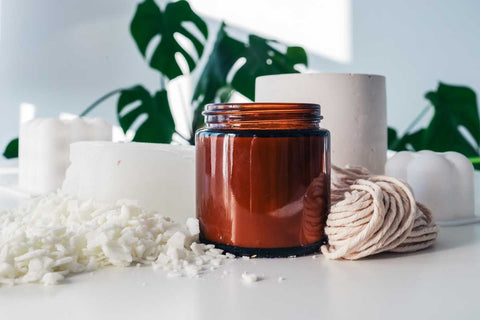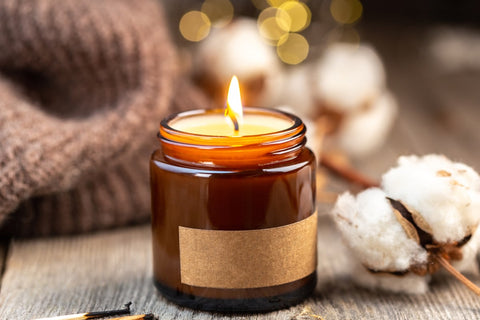We all are pretty aware of the popularity when it comes to soy candles. The main reason behind the soy wax candle's popularity is its natural property, exceptional performance, and, of course, ease of use it comes with. But not all soy waxes are hydrogenated and formulated with the same specifications.

In fact, not all soy waxes are 100% natural and pure. Some also contain blends of coconut wax and much more other wax. So, it becomes natural to expect that these may perform very differently from what pure soy candle wax would. So, in this article, we are going to discuss troubleshooting soy candles.
Types of Soy Candle Wax Problems
So, now you have made your soy wax candles, but they don't look quite right. How do you fix it? Or you came across another problem with your soy candle wax problems. This is why we are here to help you out with different types of soy candle wax problems.
1. Candle Tunneling
Candle tunneling refers to a situation where a candle burns down the middle of the wax, leaving a tunnel-like hole rather than burning evenly across the entire surface. This can occur when the candle is not burned sufficiently during the initial lighting, causing the wax to melt in a narrow tunnel down the candle's center.
2. Frosting
The frosting is a common problem that happens not just on soy candles but also on other vegetable waxes. When a soy candle is cured, certain frost-like crystals might form on the top and sides of the candles.

It will be more noticeable when your candle is colored. You must also remember that soy wax frosting is a natural property that is nearly impossible to avoid completely.
3. Wet Spots
Wet spots occur as the candle cools down in the container, and the wax also pulls away from the glassware. Wet spots are actually the wax shrinkage and air bubbles in the jars.
The wet spot problem is because of the unequal cooling speed of the candle. Some of the wax pulls off the glass while others still adhere to the walls of the container. Generally, wet spots are visually beautiful.
4. Mushrooming
The term "mushrooming" describes the accumulation of carbon and/or other particles at the wick's tip, much like black mushrooms. The primary cause is insufficient combustion. The wick, which is typically overly big, draws too much fuel from the mixture of melted wax, aroma oils, and colors.

Yet, the flame cannot burn through so much fuel at once. On the top of the wick, carbon particles eventually formed. With candles, mushrooming is a major issue because it can further result in soot and black smoke.
5. Rough Surface
The top of the final soy candle has a rough, uneven appearance, which is unsightly. If you sell candles, your buyers might think the candles are of bad quality if they have such a rough surface.
The main reason for the rough and uneven tops is an improper cooling rate, either too fast or too slow. In some cases, vigorous churning can cause the wax to absorb additional air bubbles, leading to uneven surfaces.
6. Cracking
Cracking-in soy candles cool too quickly after being poured into the candle container., This can cause the wax to contract and pull away from the sides of the container, creating a series of cracks on the surface of the candle.

It sometimes also occurs is poured at too high of a temperature or if the candle is exposed to a draft or a sudden change in temperature during the cooling process.
7. Sink Holes
On the surface of the freshly poured candles, sinkholes are frequently seen. The wax may become airtight during the melting and pouring operation. Before the candle top is cured, some bubbles may escape.
Yet, some people are unable to. The candle will eventually develop holes due to the residual air. Sinkholes come in different sizes and are unsightly if you're selling candles.
8. Smoking and Sooting
When the wick is excessively long, the candle is put in a draughty environment, or it burns for an extended period of time. Soy candles may start smoking and sooting.

While sooting refers to the discharge of black or dark particles into the air or on the candle container, smoking refers to the visible smoke that is emitted from the wick. Although soy wax candles are typically thought to burn cleaner than paraffin wax candles, they can nonetheless produce smoke and soot under certain circumstances.
9. Fragrance Leaching
Fragrance leaching of the candles generally refers to the process by which the fragrance oil in a candle evaporates or leaches out of the wax and into the surrounding environment.
This can happen when a candle is exposed to a high temperature or direct sunlight. Also, fragrance leaching can result in a weaker or less noticeable scent throw from the candle, which can be disappointing.
10. Discoloring
Discoloring is a candle problem that is not just common with soy candles but also with other natural waxes. That's because all types of natural waxes get affected by natural or artificial light over time and gradually start to lose their color.

Dye-free candles might turn yellow on the top, while colored candles may begin to fade. In some cases, those candles which contain fragrance oils are more prone to discoloration.
11. Flicking flame
Candle flickering is a frequent issue that can affect both homemade and store-bought candles. A candle's flame shakes unevenly when it is lit, almost as if it is dancing in the wind.
That can be inconvenient if you want to enjoy the warmth and light of your scented candles. Occasionally moving your candle to an area without draughts will stop your candle from flickering. Yet, a long wick or a terrible burning habit is to blame for the majority of flickering flame issues.
12. Curdling after Burning
The rough and lumpy curdling surface after burning is common in soy candles. It is caused because of the inconsistent rate of cooling and solidifying of the candle.
But the good news is that this curdling after burning won't affect the candle-burning performance. In fact, this thing might be a sign of the natural soy wax used in the candle.

How To Fix Soy Candle Wax Problems
Now as we know various types of problems associated with soy candles, it's time for us to learn how to overcome these soy candle wax problems. In this section, we are going to discuss a step-by-step guide to fix certain soy candle wax problems.
Directions:
Step 1: If your candle has tunneling, you can fix it by using a heat gun or hairdryer. This will help you melt the wax around the edges of the container. Hold the hairdryer or heat gun a few inches away from the container and move it around the edges of the container until the wax has melted and the surface is leveled.
Step 2: If your soy candle has cracks, then you can easily fix it by melting some additional wax and pouring it into the cracks. Use a heat gun or hairdryer to melt the wax around the cracks and then pour the melted wax into the cracks, filling them to the same level as the rest of the candle.

Step 3: If your candle is smoking or sooting, it could be due to a too-long wick. Trim the wick to ¼ inch and relight the candle. If the smoking and sooting continue, it could be due to other factors such as a drafty area or over-fragrancing. Make sure the candle is placed in a draft-free area.
Step 4: Storing it in a cool and dry place can avoid the fracking leaching problem. The storage place of your candle should be away from direct sunlight or other sources of heat.
Conclusion
So, this was all about troubleshooting all types of soy candle problems. From fragrance leaching to sooting and curdling, you can solve all these problems easily. So, whenever you come across any of the issues, please refer to our guide and say goodbye to candle-making issues.
Frequently Asked Questions
If you still have some concerns, here is our frequently asked question section that may resolve your additional queries.

Q. Why are my soy candles not set properly?
Ans. There could be several reasons why your soy candles are not set properly. A few common reasons include improper container size, not having the right pouring temperature, high ambient temperature, etc.
Q. What happens if you overheat soy wax for candles?
Ans. Many issues might arise from overheating soy wax for candles. The wax may get discolored, shrink, and crack if heated excessively or over an extended period of time. Moreover, the texture of the wax may become harsh or uneven, making it challenging to work with. The wax may also lose its scent if it is overheated since the heat may cause the aroma oils to evaporate.
Q. Why is my soy wax not melting?
Ans. If your soy wax is not melting, one common reason could be the wrong wick size. If the wick is too small, it cannot efficiently burn off all the wax and generate heat to form a good melt pool.












 Sign in
Sign in Register now
Register now My Reward Points
My Reward Points









